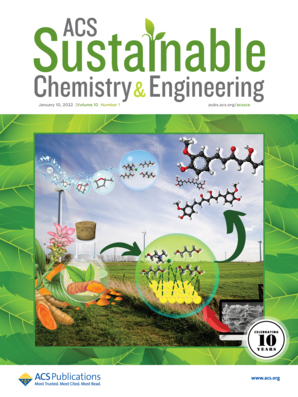Toward Low-Temperature Regeneration of CO2 Capture Adsorbents: Functionalization of Polyethylenimine
IF 7.1
1区 化学
Q1 CHEMISTRY, MULTIDISCIPLINARY
引用次数: 0
Abstract
This study aimed to design materials for CO2 capture with low regeneration temperatures without compromising the adsorption capacity (AC). Branched polyethylenimine (BPEI) functionalized with acrylonitrile (AN), 2-ethylhexyl acrylate (EHA), and butyl acrylate (BA) was impregnated onto fumed silica and tested for its adsorption and desorption properties. Higher functionalization degrees led to decreased desorption temperatures (DTs) from 73 to 97 °C to as low as 25 °C, which was attributed to the higher percentages of secondary amines upon functionalization and changes in the CO2 adsorption mechanism. However, the adsorption capacities also decreased with functionalization. Bayesian optimization using machine learning models predicted optimal compositions of adsorbents for high adsorption capacities at low regeneration temperatures. The isothermal operation of CO2 capture and release was also demonstrated to lower the energy requirement for CO2 capturing systems. The functionalized BPEI materials steadily adsorb and release CO2 for 20 cycles under isothermal conditions without any deterioration of the performance. BPEI 10,000 functionalized with AN, EHA, and BA offers a promising balance between AC and DT, making it suitable for industrial applications.

二氧化碳捕集吸附剂的低温再生:聚乙烯亚胺的功能化
本研究的目的是在不影响吸附容量(AC)的前提下,设计出再生温度较低的二氧化碳捕集材料。将丙烯腈(AN)、丙烯酸 2-乙基己酯(EHA)和丙烯酸丁酯(BA)官能化的支链聚乙烯亚胺(BPEI)浸渍到气相二氧化硅上,并测试其吸附和解吸性能。官能化程度越高,解吸温度(DTs)就越低,从 73 至 97 °C降至 25 °C,这是因为官能化后仲胺的百分比更高,二氧化碳的吸附机理也发生了变化。不过,吸附容量也随着官能化而降低。利用机器学习模型进行贝叶斯优化,预测了在低再生温度下实现高吸附容量的最佳吸附剂成分。二氧化碳捕获和释放的等温操作也被证明可以降低二氧化碳捕获系统的能源需求。在等温条件下,官能化 BPEI 材料可稳定地吸附和释放二氧化碳 20 个循环,且性能没有任何下降。用 AN、EHA 和 BA 进行官能化的 BPEI 10,000 在 AC 和 DT 之间实现了良好的平衡,适合工业应用。
本文章由计算机程序翻译,如有差异,请以英文原文为准。
求助全文
约1分钟内获得全文
求助全文
来源期刊

ACS Sustainable Chemistry & Engineering
CHEMISTRY, MULTIDISCIPLINARY-ENGINEERING, CHEMICAL
CiteScore
13.80
自引率
4.80%
发文量
1470
审稿时长
1.7 months
期刊介绍:
ACS Sustainable Chemistry & Engineering is a prestigious weekly peer-reviewed scientific journal published by the American Chemical Society. Dedicated to advancing the principles of green chemistry and green engineering, it covers a wide array of research topics including green chemistry, green engineering, biomass, alternative energy, and life cycle assessment.
The journal welcomes submissions in various formats, including Letters, Articles, Features, and Perspectives (Reviews), that address the challenges of sustainability in the chemical enterprise and contribute to the advancement of sustainable practices. Join us in shaping the future of sustainable chemistry and engineering.
 求助内容:
求助内容: 应助结果提醒方式:
应助结果提醒方式:


